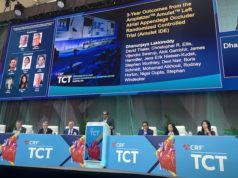
Thomas S Gilhofer (University Heart Center, Department of Cardiology, University Hospital Zurich, Zurich, Switzerland) and others report in Structural Heart that a combined procedure involving both transcatheter aortic valve implantation (TAVI) and left atrial appendage closure is a feasible approach for aortic stenosis patients with atrial fibrillation and contraindications to oral anticoagulation.
Gilhofer et al note that oral anticoagulation is used to mitigate the risk of stroke in patients with atrial fibrillation but add that it increases the risk of bleeding and this risk “is especially pronounced in contemporary TAVI candidates who are mostly elderly and frail”. They add that some of the differences in prognosis between TAVI patients with atrial fibrillation and those without—i.e. it is generally worse in atrial fibrillation patients—may be attributable to the increased risk of bleeding associated with oral anticoagulation. Therefore, left atrial appendage closure may be option for atrial fibrillation patients undergoing TAVI; specifically, those who have relative or absolute contraindication to oral anticoagulation.
The authors write that a previous study has already explored the feasibility of combining TAVI with left atrial appendage closure but write that “different prosthesis in different centres were combined and not compared to a left atrial appendage occlusion group.” Thus, the aim of the present study was to review the feasibility of combining TAVI and left atrial appendage closure procedures using one device type (Lotus and Watchman respectively; both Boston Scientific) and to compare the combined procedure with TAVI alone and with left atrial appendage closure alone.
Of 52 patients enrolled in the study, 19 underwent an isolated TAVI procedure, 23 underwent isolated left atrial appendage closure, and 10 underwent a combined procedure. Gilhofer et al state there was not significant difference in contrast use between the difference procedures but acknowledge this finding may relate to their small sample size (previous studies of combined percutaneous approaches have shown an increase in contrast use). “Our numbers are reassuring in that in there is no alarming increase of contrast dye to be expected by combining TAVI and left atrial appendage closure,” they observe. As to be expected, procedural time was significantly greater in the combined group vs. the isolated TAVI group (82±16.6 minutes vs. 57±18 minutes for TAVI vs. 42.7±16 minutes for the isolated left atrial appendage closure group; p=0.001).
At the 30-day post procedure follow-up point, no patients had died in either the isolated TAVI group or in the isolated left atrial appendage closure group. One patient in the combined group died of sudden cardiac arrest on day 28 (two weeks after an event-free hospital stay).
The authors comment: “Our study shows that simultaneous TAVI and left atrial appendage closure procedure using a Lotus vale and a Watchman device is feasible and comparable to both interventions as standalone procedures.” They add that a combined approach avoids the need for a second procedure and also omits the need for lifelong anticoagulation but state that “long-term follow-up will show whether combining TAVI and left atrial appendage improves the prognosis in high-risk patients with atrial fibrillation”.
Gilhofer told Cardiovascular News: “While during open heart surgery the combination of various simultaneous interventions (e.g. aortic valve replacement with aorto-coronary bypass grafting) is widely accepted, combined approaches during percutaneous interventions are still debated. Reducing the number of procedures performed increases patient comfort and satisfaction and reduces hospitalisations as well as the number of in-hospital days. Despite the limited number of procedures in our study, we were able to show that simultaneous TAVI and left atrial appendage closure with Lotus and Watchman is feasible and comparable to both interventions as stand-alone procedures, although procedural time was higher when both interventions were performed simultaneously. We therefore plea for an open approach to combining percutaneous transcatheter interventions if indicated.”









